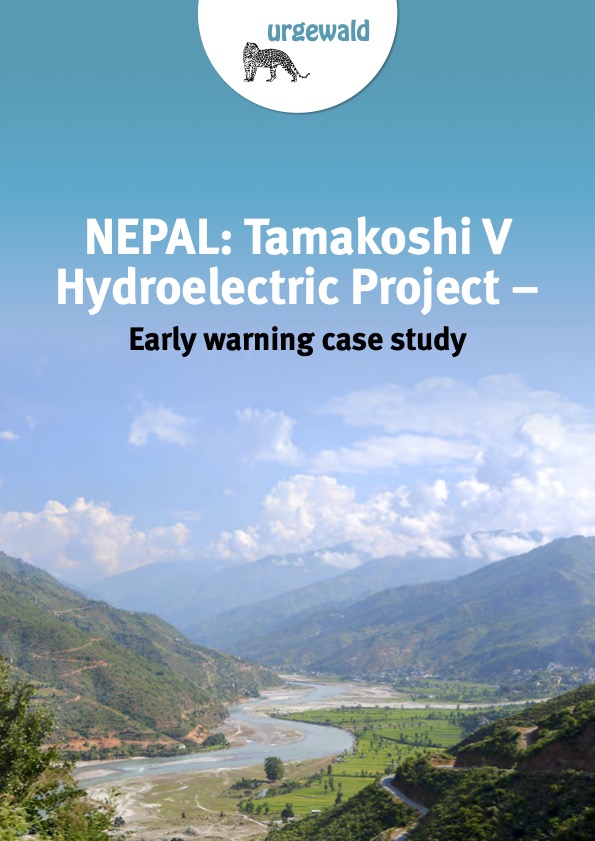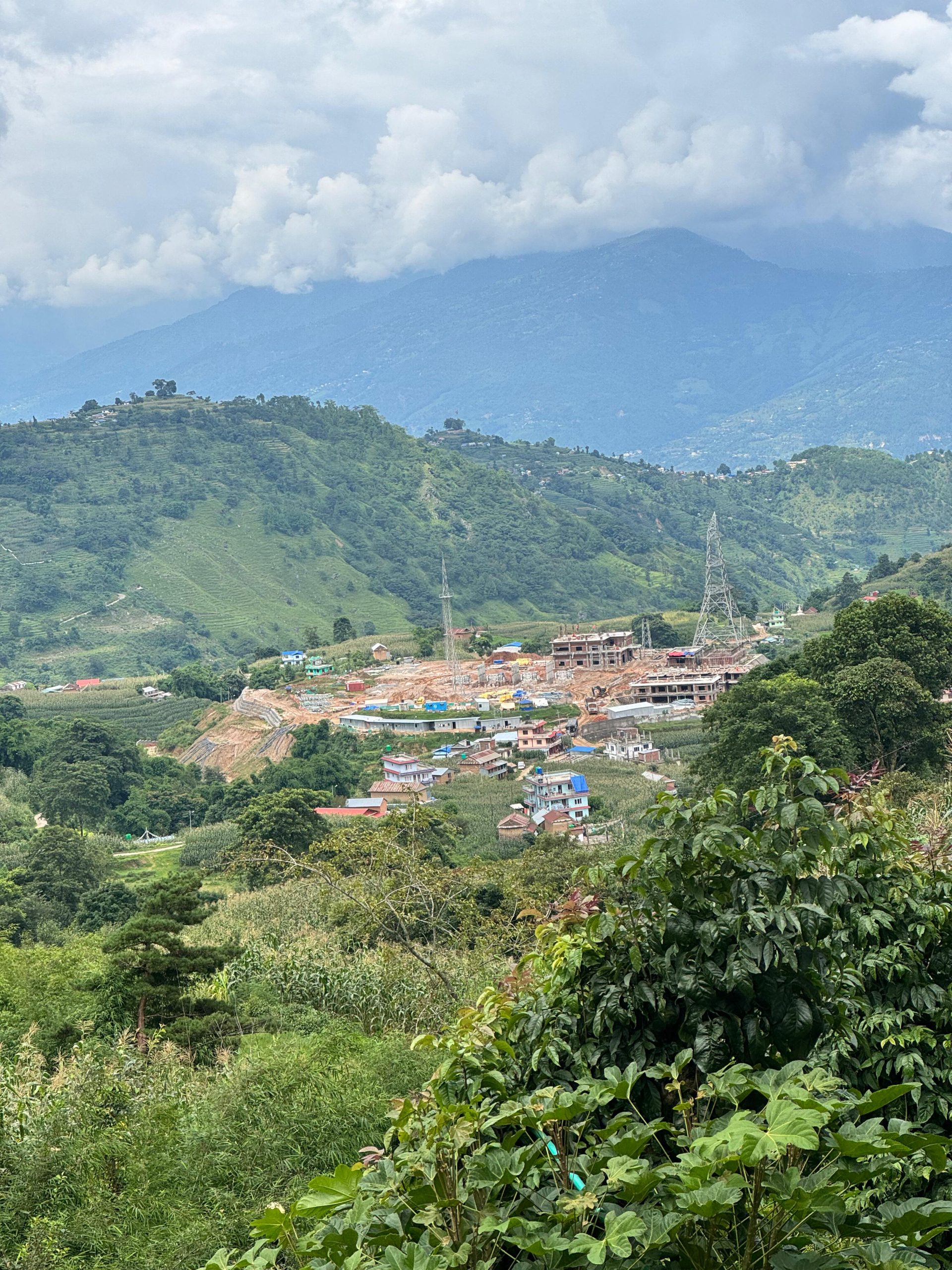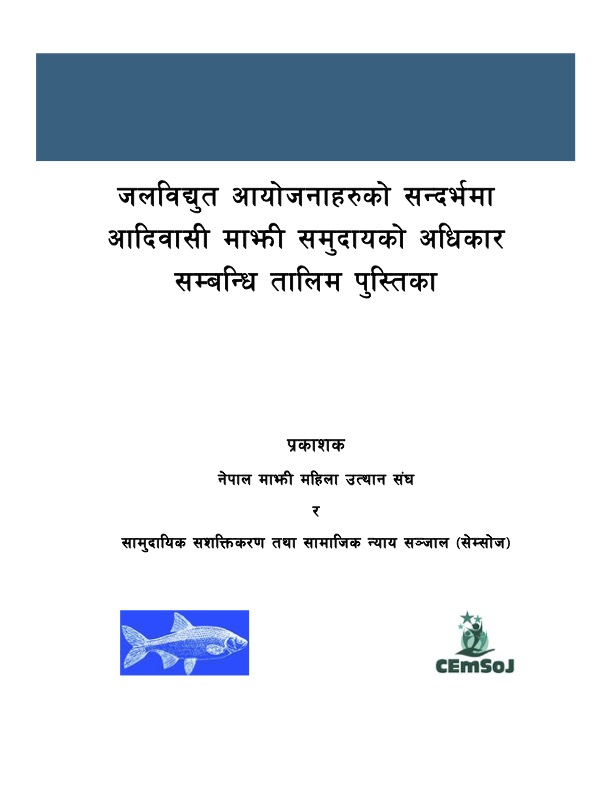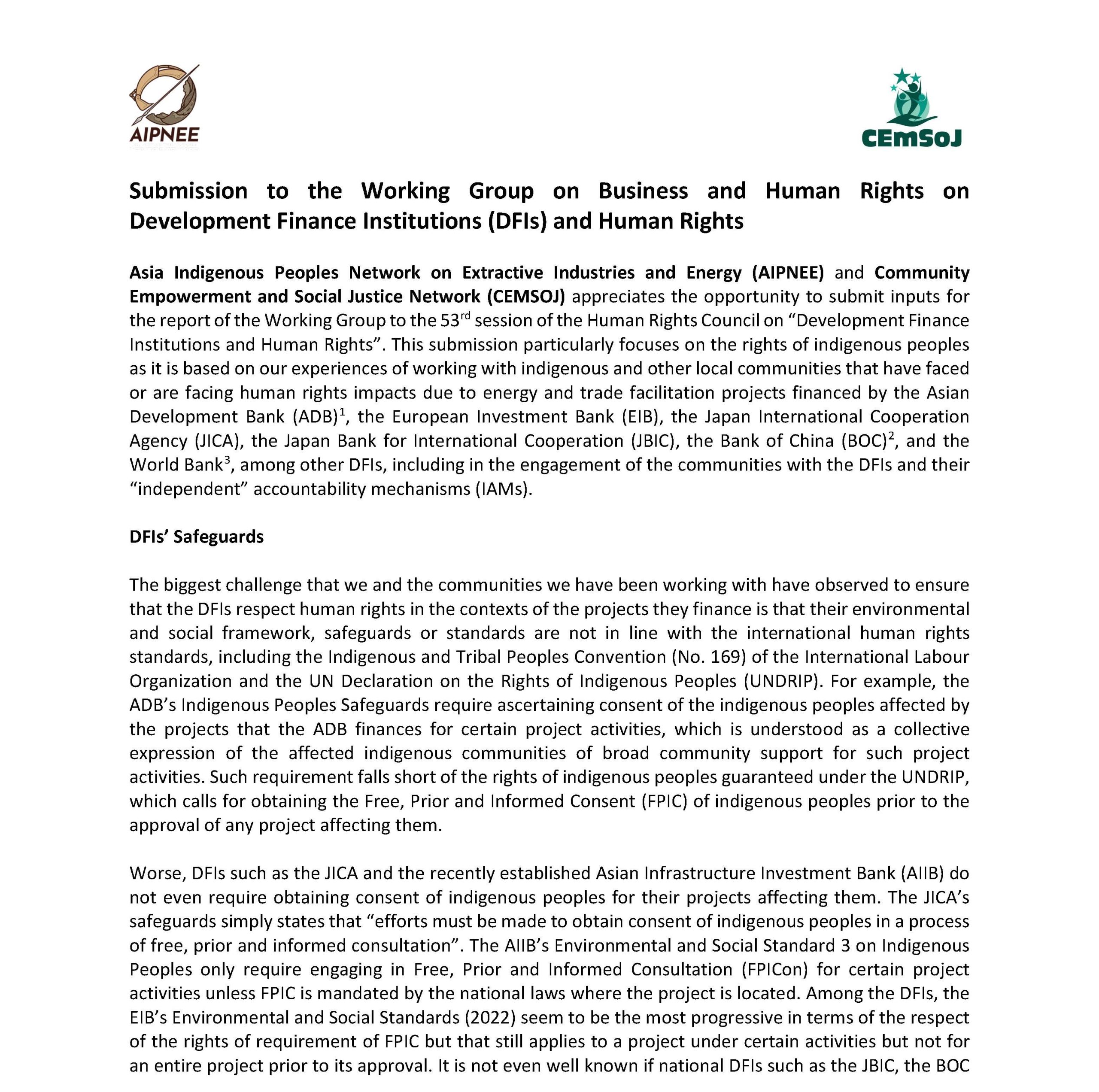काठमाडौंको उत्तरपूर्वमा अवस्थित शङ्खरापुर नगरपालिकाको बोझेनीका आदिवासी तामाङ र स्थानीय समुदायले आज एसियाली विकास बैंक (एडीबी) को जवाफदेहिता संयन्त्रको अनुपालन समीक्षा प्यानल (सीआरपी) मा उजुरी दर्ता गरेका छन्। उजुरीमा उनीहरूले बोझेनीमा निर्माणाधीन तामाकोशी-काठमाडौं २२०/४०० केभी प्रसारण लाइन र यसको सवस्टेसन स्थानान्तरण हुनुपर्ने उनीहरुको मागको सम्बन्धमा एडीबीको सुरक्षण नीति र कार्यविधि पालना भएको सुनिश्चित गर्न सीआरपीलाई अनुरोध गरेका छन्।
more “तामाकोशी-काठमाडौं प्रसारण लाइनबाट प्रभावित आदिवासी तामाङ तथा स्थानीय समुदायद्वारा एडीबीको अनुपालन समीक्षा प्यानलमा उजुरी”Tag: hydropower
Indigenous Tamang and local communities affected by Tamakoshi-Kathmandu Transmission Line file complaint to ADB’s Compliance Review Panel
Indigenous Tamang and local communities of Bojheni in Shankharapur municipality in the northeast of Kathmandu filed a complaint today with the Compliance Review Panel (CRP) of the Asian Development Bank’s (ADB) Accountability Mechanism. In the complaint, they have requested the CRP to ensure ADB’s Safeguards policy and procedural compliance in relation to their demands of relocation of the Tamakoshi–Kathmandu 220/400 kV Transmission Line and its substation in Bojheni being forcefully constructed on their lands.
more “Indigenous Tamang and local communities affected by Tamakoshi-Kathmandu Transmission Line file complaint to ADB’s Compliance Review Panel”Joint submission on the human rights situation of Indigenous Newa communities made to the UN for the 4th Universal Periodic Review of Nepal
Community Empowerment and Social Justice Network (CEMSOJ), Save Nepa Valley (SNV) Movement and Thāe Bāe Yā Lwāpu made a joint submission for the 4th Universal Periodic Review (UPR) of Nepal. The UPR is a unique process which involves a review of the human rights records of all UN Member States and is held under the auspices of the UN Human Rights Council. The submission presents key human rights challenges faced by indigenous Newa communities, particularly in the context of “development” and business projects in Nepal and the systematic violations of rights to housing and property as well as cultural rights of the Jugi community within the Indigenous Newa nationality of Nepal. It also examines the compliance of the Government of Nepal with relevant recommendations received during the 3rd and 2nd UPR cycles of Nepal related to the rights of Newa and other Indigenous nationalities.
more “Joint submission on the human rights situation of Indigenous Newa communities made to the UN for the 4th Universal Periodic Review of Nepal”जलविद्युत आयोजनाहरुको सन्दर्भमा आदिवासी माझी समुदायको अधिकार सम्बन्धि तालिम पुस्तिका
वि.सं. २०८१ चैत १५
जलविद्युत आयोजनाहरुको सन्दर्भमा आदिवासी माझी समुदायको अधिकार विषयक यस तालिम पुस्तिकाले आदिवासी माझी समुदायलाई सशक्त बनाउनको लागि एक बृहत् स्रोतको रुपमा काम गर्ने उद्देश्य लिएको छ । यसले जलविद्युत परियोजनाहरूको प्रभावको सन्दर्भमा समुदायको अधिकारको वकालतको लागि जनचेतना अभिबृद्धि र क्षमता विकासको लागि तत्काल रहेका आवश्यकताहरूलाई सम्बोधन गर्ने लक्ष्य राखेको छ । यो पुस्तिका माझी समुदायका अगुवा, अधिकार प्रतिरक्षक र अन्य मानवअधिकार तथा आदिवासी अधिकार प्रतिरक्षकहरूलाई सुनकोशी–३ र दुधकोशी जलविद्युत आयोजनाहरूको सम्बन्धमा बुझाई वृद्धि, अन्तर्राष्ट्रिय र राष्ट्रिय कानून अन्तर्गत आदिवासी जनजातिको अधिकारको प्राविधिक ज्ञान, व्यवहारिक वकालत, तालिम र जनचेतना अभिबृद्धिका लागि सीप विकासमा सहयोग गर्न तयार पारिएको छ ।
more “जलविद्युत आयोजनाहरुको सन्दर्भमा आदिवासी माझी समुदायको अधिकार सम्बन्धि तालिम पुस्तिका”Tamakoshi V Hydroelectric Project: Early Warning Case Study
This case study on the Tamakoshi V Hydroelectric Project aims to analyze the impacts of the Project during its early stages of implementation in order to identify potential gaps in the accountability framework for the Project in line with the policies of its financier Asian Infrastructure Investment Bank (AIIB) as well as wider impacts of the Project in the context of cumulative impacts of the cascade dams being built or planned in the Tamakoshi River. Further, the case study seeks to look into the Project to determine if it is in line with the environmental sustainability and fiscal stability of Nepal.

The case study calls for calls for serious reassessment of the Project on the grounds of outdated feasibility study and inadequate information disclosure, lack of participation and consent of the affected communities, and potential cumulative environmental harms, among other concerns. It is based on desk review of the official Project documents, relevant policies of the AIIB and laws and policies of Nepal as well as media, governmental and non-governmental reports on the Project and other associated projects. While CEMSOJ has made initial efforts to reach out to the affected communities of the Project to understand their perspectives of and aspirations with the Project at the ground level, lack of such information gathered so far poses a major limitation for this study . In order to address that, it is planned that this study will later be complemented by field visits to the affected communities.
more “Tamakoshi V Hydroelectric Project: Early Warning Case Study”AIPNEE and CEMSOJ’s joint submission to the UN Working Group on Business and Human Rights for its forthcoming country visit to Japan
Asia Indigenous Peoples Network on Extractive Industries and Energy (AIPNEE) and Community Empowerment and Social Justice Network (CEMSOJ) made a joint submission to the UN Working Group on Business and Human Rights on Monday for its forthcoming official country visit to Japan. The submission particularly focuses on the roles of Japanese institutions in providing assistance or financing projects that harm Indigenous Peoples in countries across Asia and the lack of accountability of those institutions to remedy such harms. It is based on our experiences of working with Indigenous communities that have faced or are facing human rights impacts due to energy and other projects reportedly or being (co-)financed by the Japan International Cooperation Agency (JICA)[1] and the Japan Bank for International Cooperation (JBIC)[2].
The submission details the challenges that are faced in seeking accountability of these mechanisms and accordingly provides recommendations.
more “AIPNEE and CEMSOJ’s joint submission to the UN Working Group on Business and Human Rights for its forthcoming country visit to Japan”Joint submission to the UN Special Rapporteur calling attention to the continued concerns of Indigenous Magar and other local communities affected by Tanahu Hydropower Project in western Nepal
Community Empowerment and Social Justice Network (CEMSOJ), Indigenous Women Legal Awareness Group (INWOLAG), International Accountability Project (IAP) and NGO Forum on ADB made a joint submission to the newly appointed UN Special Rapporteur on the Right to Development on Tuesday to draw his attention to the continued concerns of Indigenous Magars and other local communities affected by the Tanahu Hydropower Project in western Nepal and calling for his action to safeguard the rights of the affected communities.
The Asian Development Bank (ADB), the European Investment Bank (EIB), the Japan International Cooperation Agency (JICA) and the Government of Nepal are co-financing the 140 MW reservoir type Project. Since the beginning of the Project, one main concern was the absence of accessible and timely information disclosure. In 2020, affected Indigenous Magar and other local communities submitted various complaints to the independent accountability mechanims of the ADB and the EIB calling for respect of their free, prior and informed consent (FPIC) in the Project decisions affecting them and for land-for-land and house-for-house compensation for the land and houses that will be impacted by the Project, among other demands such as restoration of communal resources such as grazing lands, sacred sites and forests as well as sharing of benefits of the Project. Further, they have also raised concerns about environmental risks posed by the impending inundation of the Project as well as ongoing illegal sand and stone mining on the riverbanks in the inundation area affecting their lands and settlements. Their complaints have results in dispute resolution processes facilitated by the ADB’s Office of the Special Project Facilitator (OSPF) and the EIB-Complaint Mechanim (EIB-CM), which are at various stages.
more “Joint submission to the UN Special Rapporteur calling attention to the continued concerns of Indigenous Magar and other local communities affected by Tanahu Hydropower Project in western Nepal”AIPNEE and CEMSOJ’s joint submission on Development Finance Institutions and Human Rights to the UN
Below is the joint submission made by Asia Indigenous Peoples Network on Extractive Industries and Energy (AIPNEE) and Community Empowerment and Social Justice Network (CEMSOJ) to the UN Working Group on Business and Human Rights for their forthcoming report on “Development Finance Institutions (DFIs) and Human Rights”. The submission particularly focuses on the rights of indigenous peoples based on the experiences of AIPNEE and CEMSOJ of working with indigenous and other local communities that have faced or are facing human rights impacts due to energy and trade facilitation projects financed by various DFIs.
Click here for the PDF of the submission.
more “AIPNEE and CEMSOJ’s joint submission on Development Finance Institutions and Human Rights to the UN”Nepal: Stop State brutality against the Indigenous Tamangs and other Locals for the construction of Tamakoshi-Kathmandu 220/400 kV Transmission Line Project in Shankharapur, Kathmandu
CEMSOJ joins organizations and individuals worldwide in the following public statement issued to the concerned authorities of Nepal and the Asian Development Bank (ADB).
Nepal: Stop State brutality against the Tamang Indigenous Peoples and Locals

Stop the construction of Tamakoshi-Kathmandu 220/400 kV Transmission Line Project in Shankharapur-3, Kathmandu
We, the undersigned organizations and individuals, strongly condemn the ongoing repression by Nepal’s police and armed police forces on the indigenous Tamang and other locals in Bojheni village, Shankharapur municipality Ward no. 3 in the northeast of Kathmandu for the construction of Tamakoshi-Kathmandu 200/400 kV Transmission Line and its substation.
more “Nepal: Stop State brutality against the Indigenous Tamangs and other Locals for the construction of Tamakoshi-Kathmandu 220/400 kV Transmission Line Project in Shankharapur, Kathmandu”Tamakoshi-Kathmandu Transmission Line affected communities call on the Asian Development Bank to realign the power line and relocate its sub-station
3 November 2021, Kathmandu
Indigenous Tamang and other locals of Shankharapur municipality in the northeast of Kathmandu affected by the Tamakoshi-Kathmandu 200/400 kV Transmission Line and its Bojheni substation today submitted a memorandum to the Asian Development Bank (ADB) Nepal Resident Mission. They have called for realignment of the Transmission Line and shifting of the sub-station from their settlement area as planned under the ADB-financed Electricity Transmission Expansion and Supply Improvement Project.
In the memorandum emailed to the ADB with signatures of more than 200 affected locals, the Upper Tamakoshi Hydropower Project Victims’ Struggle Society has alleged that they have not been adequately informed about the impacts of the Transmission Line and the sub-station and the land acquisition has been undertaken through intimidation of the landowners. The construction of the Transmission Line and its sub-station has been halted for the last two years due to the opposition of the locals. They allege that the Project is seeking to construct the Bojheni substation in an unauthorized manner without agreement of the locals. Further, the Transmission Line running over their houses, lands and religious and cultural sites will devaluate their properties, significantly affect their livelihoods dependent on agriculture and tourism as well as the environment and even cause insecurity to their health and lives, which will eventually displace them from their ancestral lands and settlement.
more “Tamakoshi-Kathmandu Transmission Line affected communities call on the Asian Development Bank to realign the power line and relocate its sub-station”

